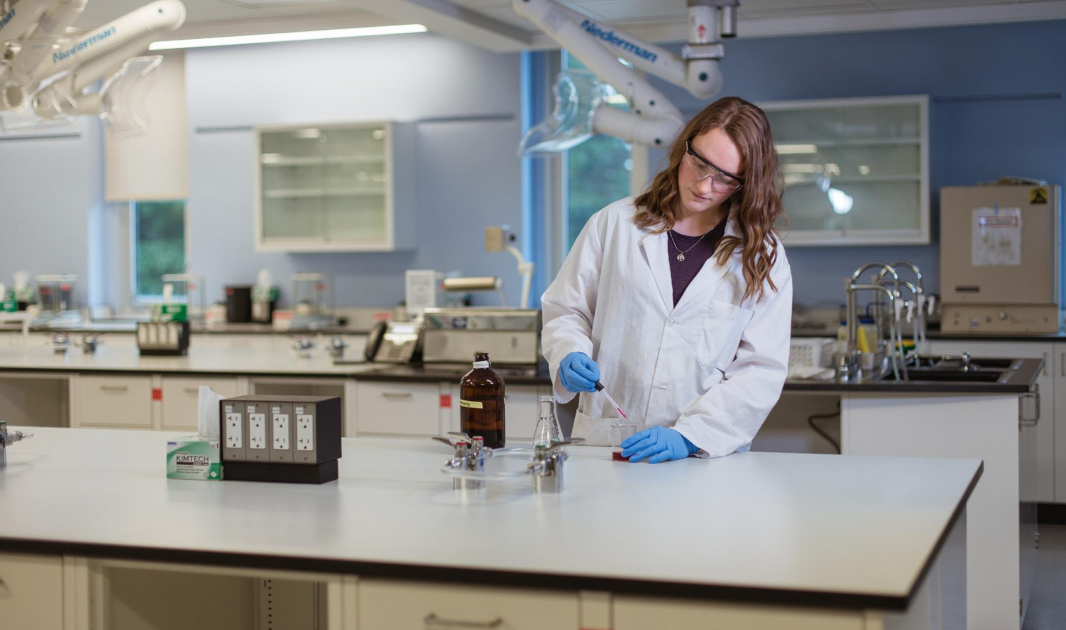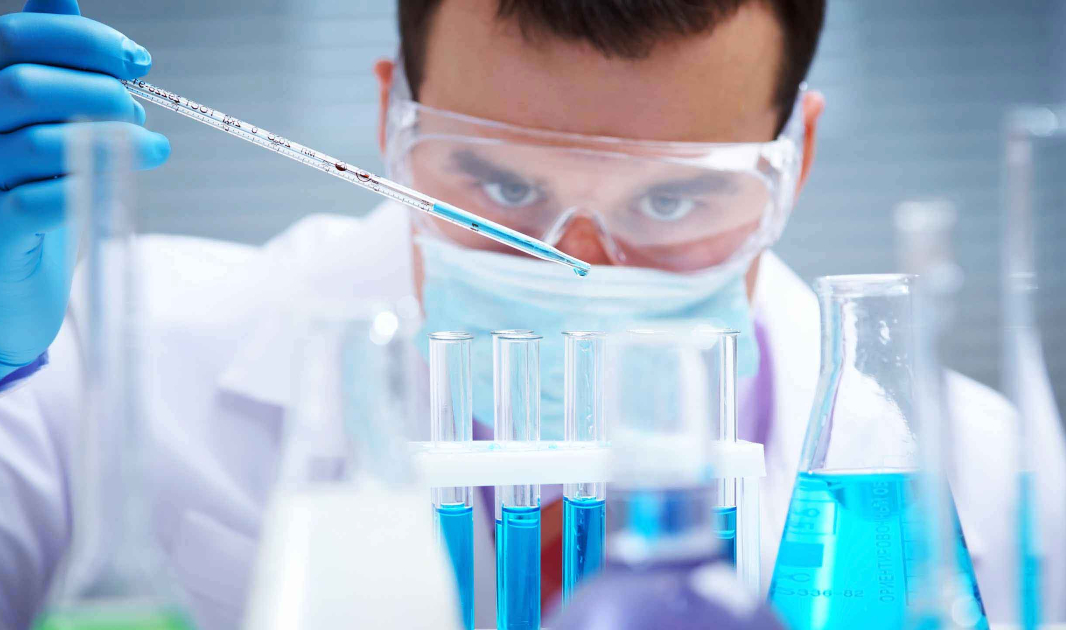From hydrogen peroxide to sulphuric acid, a variety of different chemicals are used in the laboratory.
They have a wide range of applications and are commonly used to test and synthesise new substances.
Many of the most common chemicals used in chemistry laboratories, including those in schools, are hazardous.
Some are corrosive, while others are flammable, toxic, or poisonous. A few are even potentially explosive. It’s therefore essential to always wear protective clothing and equipment when handling chemicals in the laboratory.
Inorganic bases – these are alkaline substances that contain hydroxide functional groups. Many inorganic bases are metal hydroxide compounds, like sodium hydroxide, potassium hydroxide, and calcium hydroxide.

Types of chemicals found in a chemistry lab
The chemicals found in a chemistry lab are usually high-grade chemicals, which means they have high levels of purity. They can be grouped into different categories based on their reactivity and chemical properties.
Some of the categories of chemicals that are commonly found in laboratories are the following:
- Oxidising acids – although these chemicals have a low pH, they’re capable of stripping away electrons from other substances. Examples of oxidising acids include nitric acid, perchloric acid, and hydrogen peroxide.
- Flammable liquids – these are volatile chemicals that can burst into flames when ignited. Examples include methanol, ethanol, acetone, xylene, and toluene.
- Poisons & toxic chemicals – these chemicals are lethal when ingested, especially at high concentrations. Many are in mixture forms, but some are also in pure forms. Acrylamide, formaldehyde, chloroform, phenol, and toxic metal salts such as silver chloride and cadmium sulphate all come under this category.
- Organic acids – these types of acids contain carbon or carbon chains. Common examples include butyric acid and pentanoic acid.
- Organic bases – the chemicals belonging to this category are alkaline substances with high pH values. They also contain carbons or carbon chains. Examples of organic bases include amines such as ethanolamine and tributylamine.
- Salts – often produced through neutralisation reactions between acids and bases, these are ionic compounds with a neutral pH. Examples of salts include sodium bisulphate, copper sulphate, sodium chloride, and ammonium fluoride.
- Pyrophorics – chemicals that react easily with air are called pyrophoric substances. Examples include phosphorus, methyllithium, trimethylaluminum, diethylzinc, and phenyllithium.
- Sulphides – as the name suggests, sulphides are compounds that contain sulphur. Some of them, such as potassium sulphides, are also pyrophoric. Other examples of substances in this category are lead sulphide and iron sulphide.
- Cyanides – these compounds are highly poisonous. Each molecule contains one carbon and one nitrogen atom. Common examples include sodium cyanide and potassium cyanide.
- Inorganic acids – these acids don’t contain carbon and are usually strong acids. Hydrochloric acid, sulphuric acid, and phosphoric acid are all types of inorganic acids.
- Inorganic bases – these are alkaline substances that contain hydroxide functional groups. Many inorganic bases are metal hydroxide compounds, like sodium hydroxide, potassium hydroxide, and calcium hydroxide.

Most common chemicals in a chemistry lab
Some of the most common chemicals in a chemistry laboratory are used as solvents, reagents, and catalysts. Others are used as cleaning agents or as fuel. Here are some examples.
1. Ethanol
Found in wine, beer, whiskey, and other alcoholic beverages, ethanol is the only alcohol that’s safe for human consumption. It’s prepared through the fermentation of sugars from fruits or carbohydrates from grains. Laboratory-grade ethanol is produced through the distillation of the alcohol from fermented solutions.
Ethanol is mainly used in the laboratory as a solvent in the synthesis of other organic compounds. It’s also commonly used as an additive in fuels and as a disinfectant and cleaning agent.
2. Benzene
Benzene is an aromatic hydrocarbon that’s commonly used as a solvent and a precursor for synthesising other organic compounds like plastics, resins, synthetic fibres, rubber lubricants, and dyes.
3. Hydroxide
Hydroxide is the functional group of alcohols and inorganic metal bases. It can have many functions depending on the group to which it is attached. For example, it can be a base or a proton acceptor. Hydroxide can also act as a ligand and a catalyst.
4. Pyridine
Pyridine is a heterocyclic compound with the chemical formula C5H5N. Classed as a weak base, it’s a highly flammable liquid that’s completely miscible with water. It’s also known for its distinct fish-like smell. Pyridine is widely used as a reagent and precursor to many products such as medicines, vitamins, pesticides, paints, and food flavourings.
5. Methanol
Methanol is another common alcohol found in the laboratory. It’s mainly used during analytical methods like chromatography and spectrometry, as well as in the synthesis of biodiesel.
The importance of safety in a chemical lab
Safety is paramount in a chemical laboratory. Working in an unsafe environment can put both people and property in danger. You can help to prevent accidents and injury by following certain safety protocols. The simplest and most effective safety protocol is to wear PPE such as lab gowns, rubber gloves, goggles, and face masks or breathing apparatus.
The type of PPE you should wear depends on the specific chemical you’re working with and the dangers it poses. Some chemicals also require special environmental conditions to maintain stability. Flammable chemicals, for instance, shouldn’t be stored at high temperatures or near ignition sources such as bunsen burners.
How Evolve can help
At Evolve, we are proud to be the largest independent supplier of scientific supplies, including chemicals, laboratory equipment and consumables in Malta and can deliver the chemicals you need quickly and simply.
We supply an extensive range of chemicals to a wide range of laboratories, including biological reagents, non-aqueous titrants, pH buffers, storage and cleaning solutions for pH electrodes as well as general chemicals from trusted brand partners such as Merck.
Our team of experts are always on hand to help you choose the right chemicals and techniques for your scientific project, depending on your analysis, application and requirements.
To find out how we can save you time and give you one less thing to worry about, visit our Support Centre page.
Looking for more ideas?
Our programmes and partnerships, innovations and investments, and the positive impact we’re having in our communities
Laboratory equipment and more
Whatever your next step, we’ll be by your side.
Evolve is Malta’s fastest growing science company, offering lab design, scientific consultancy services, environmental monitoring and the latest medical equipment from internationally trusted brands.
We have a comprehensive range of scientific equipment and medical supplies, shaped to suit the needs of hospitals, clinics, heritage sites, school labs, universities, medical cannabis facilities and leading pharmaceutical companies.
To find out about how Evolve can help you take your next step, get in touch with us today.


